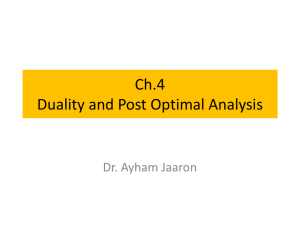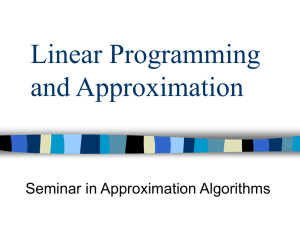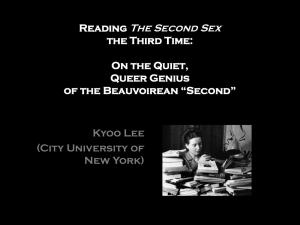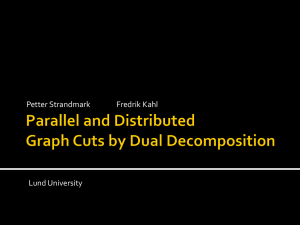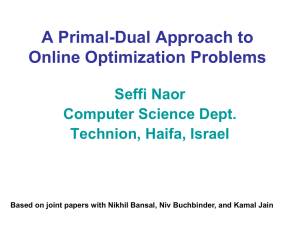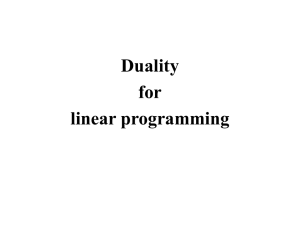PPTX
advertisement
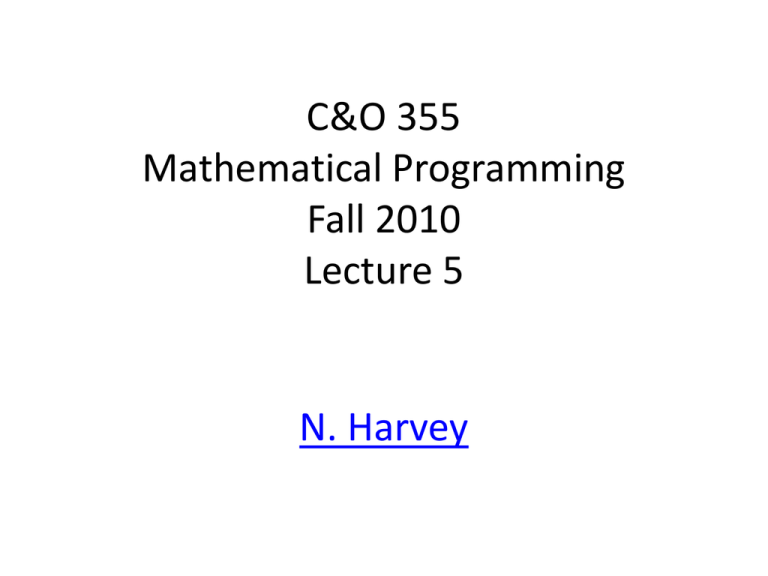
C&O 355
Mathematical Programming
Fall 2010
Lecture 5
N. Harvey
Review of our Theorems
Primal LP:
Dual LP:
• Fundamental Theorem of LP: Every LP is either
Infeasible, Unbounded, or has an Optimal Solution.
– Not Yet Proven!
• Weak Duality Theorem: If x feasible for primal and y
feasible for dual then cTx · bTy.
• Strong LP Duality Theorem:
9x optimal for primal ) 9y optimal for dual.
Furthermore, cTx=bTy.
Since the dual of the dual is the primal, we also get:
9y optimal for dual ) 9x optimal for primal.
Variant of Strong Duality
Primal LP:
Dual LP:
• Fundamental Theorem of LP: Every LP is either
Infeasible, Unbounded, or has an Optimal Solution.
• Variant of Strong LP Duality Theorem:
If primal is feasible and dual is feasible, then
9x optimal for primal and 9y optimal for dual.
Furthermore, cTx=bTy.
• Proof: Since primal and dual are both feasible,
primal cannot be unbounded.
(by Weak Duality)
By FTLP, primal has an optimal solution x.
By Strong Duality, dual has optimal solution y and cTx=bTy. ¥
Proof of Variant from Farkas’ Lemma
Primal LP:
Dual LP:
• Theorem: If primal is feasible and dual is feasible, then
9x optimal for primal and 9y optimal for dual.
Furthermore, cTx=bTy.
• Existence of optimal solutions is equivalent to solvability of
{ A x · b, AT y = c, y ¸ 0, cT x ¸ bT y }
• We can write this as:
• Suppose this is unsolvable.
• Farkas’ Lemma: If Mp ·d has no solution, then
9q¸0 such that qT M=0 and qTd < 0.
• Farkas’ Lemma: If Mp ·d has no solution, then
9q¸0 such that qT M=0 and qTd < 0.
Note: ® 2 R
• So if this is unsolvable, then there exists [ u, v1, v2, w, ® ] ¸ 0 s.t.
[ u, v1, v2, w, ® ] M = 0
[ u, v1, v2, w, ® ] [ b, c, -c, 0, 0 ]T < 0
• Equivalently, let v = v2-v1. Then 9 u¸0, w¸0, ®¸0 such that
uT A - ® cT = 0
-vT AT - wT + ® bT = 0
uT b - vT c < 0
• Equivalently, 9u¸0, ®¸0 such that
AT u = ® c
Av·®b
bT u < cT v
Primal LP:
Dual LP:
• We’ve shown: if primal & dual have no optimal solutions, then
9u¸0, ®¸0 such that ATu = ®c, Av · ®b, bTu < cTv.
• Case 1: ®>0. WLOG, ®=1. (Just rescale u, v and ®.)
Then Av · b ) v feasible for primal.
ATu = c, u ¸ 0 ) u is feasible for dual.
bTu < cTv ) Weak Duality is violated. Contradiction!
• Case 2: ®=0.
Let x be feasible for primal and y feasible for dual. Then
uT b ¸ uT (Ax) = (uTA) x = 0Tx = 0Ty ¸ (vTAT) y = vT (AT y) = vT c
Since u¸0 and Ax·b
Since uT A = 0
Since Av·0 and y¸0
This contradicts bTu < cTv!
• So primal and dual must have optimal solutions.
Since AT y=c
¥
Primal LP:
Dual LP:
• Theorem: (Variant of Strong Duality)
If primal is feasible and dual is feasible, then
9x optimal for primal and 9y optimal for dual.
• Fundamental Theorem of LP: Every LP is either
Infeasible, Unbounded, or has an Optimal Solution.
• Lemma: Primal feasible & Dual infeasible ) Primal unbounded.
– You’ll solve this on Assignment 2.
• Proof of FTLP:
If Primal is infeasible or unbounded, we’re done.
So assume Primal is feasible but bounded.
By Lemma, Dual must be feasible.
By Theorem, Primal has an optimal solution.
¥
Complementary Slackness
• Simple conditions showing when feasible
primal & dual solutions are optimal.
• (Sometimes) Gives a way to construct dual
optimal solution from primal optimal solution.
Duality: Geometric View
• We can “generate” a new constraint aligned with c by
taking a conic combination (non-negative linear combination)
of constraints tight at x.
• What if we use constraints not tight at x?
x2
-x1+x2· 1
x
x1 + 6x2 · 15
Objective Function c
x1
Duality: Geometric View
• We can “generate” a new constraint aligned with c by
taking a conic combination (non-negative linear combination)
of constraints tight at x.
• What if we use constraints not tight at x?
x2
-x1+x2· 1
x
Doesn’t prove x is optimal!
x1 + 6x2 · 15
Objective Function c
x1
Duality: Geometric View
• What if we use constraints not tight at x?
• This linear combination is a feasible dual solution,
but not an optimal dual solution
• Complementary Slackness: To get an optimal dual
solution, must only use constraints tight at x.
x2
-x1+x2· 1
x
Doesn’t prove x is optimal!
x1 + 6x2 · 15
Objective Function c
x1
Primal LP
Weak Duality
Dual LP
Theorem: “Weak Duality Theorem”
If x feasible for Primal and y feasible for Dual then cTx · bTy.
Proof: cT x = (AT y)T x = yT A x · yT b. ¥
Since y¸0 and Ax·b
Primal LP
Weak Duality
Dual LP
Theorem: “Weak Duality Theorem”
If x feasible for Primal and y feasible for Dual then cTx·bTy.
Proof:
When does equality hold here?
Corollary:
If x and y both feasible and cTx=bTy then x and y are both optimal.
Primal LP
Weak Duality
Dual LP
Theorem: “Weak Duality Theorem”
If x feasible for Primal and y feasible for Dual then cTx·bTy.
Proof:
When does equality hold here?
Equality holds for ith term if either yi=0 or
Primal LP
Weak Duality
Dual LP
Theorem: “Weak Duality Theorem”
If x feasible for Primal and y feasible for Dual then cTx·bTy.
Proof:
Theorem: “Complementary Slackness”
Suppose x feasible for Primal, y feasible for dual, and
for every i, either yi=0 or
.
Then x and y are both optimal.
Proof: Equality holds here. ¥
General Complementary
Slackness Conditions
Let x be feasible for primal and y be feasible for dual.
Primal
Dual
Objective
max cTx
min bTy
Variables
x1, …, xn
y1,…, ym
Constraint matrix
A
AT
and
Right-hand vector
b
c
Constraints
versus
Variables
ith constraint: ·
ith constraint: ¸
ith constraint: =
yi ¸ 0
yi · 0
yi unrestricted
for all j,
equality holds either
for primal or dual
xj ¸ 0
xj · 0
xj unrestricted
jth constraint: ¸
jth constraint: ·
jth constraint: =
for all i,
equality holds either
for primal or dual
,
x and y are
both optimal
Example
• Primal LP
• Challenge:
– What is the dual?
– What are CS conditions?
• Claim: Optimal primal solution is x=(3,0,5/3).
Can you prove it?
Primal LP
Example
Dual LP
• CS conditions:
–
–
–
–
Either x1+2x2+3x3=8
Either 4x2+5x3=2
Either y1+2y+2+4y3=6
Either 3y2+5y3=-1
or y2=0
or y3=0
or x2=0
or x3=0
• x=(3,0,5/3) ) y must satisfy:
• y1+y2=5
y3=0
) y = (16/3, -1/3, 0)
y2+5y3=-1
Since y is feasible for the dual, y and x are both optimal.
If y were not feasible, then x would not be optimal.
Complementary Slackness Summary
• Gives “optimality conditions” that must be
satisfied by optimal primal and dual solutions
• (Sometimes) gives useful way to compute
optimum dual from optimum primal
• Extremely useful in “primal-dual algorithms”.
Much more of this in
– C&O 351: Network Flows
– C&O 450/650: Combinatorial Optimization
– C&O 754: Approximation Algorithms
